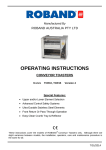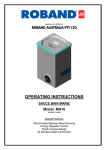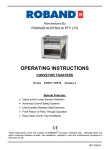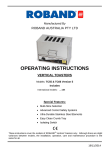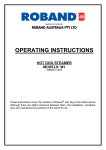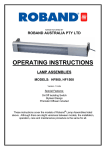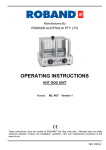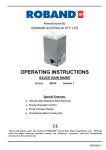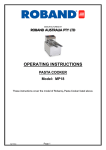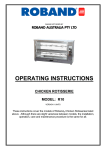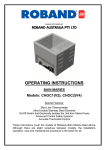Download OPERATING INSTRUCTIONS
Transcript
MANUFACTURED BY ROBAND AUSTRALIA PTY LTD OPERATING INSTRUCTIONS CHIP WARMER Model: CW10 VERSION 3 UNITS Special Features: Halogen Heat Lamps Ultra-Durable Stainless Steel Elements Easy Clean Tank Roband Australia is a wholly Australian owned company, which has been manufacturing quality commercial catering equipment for the food service industry for more than 45 years. Roband products are engineered and manufactured to the highest standards to provide functionality, reliability and durability, and our quality products are exported world-wide. Included in the comprehensive Roband® range are Toasters, Fryers, Milkshake Mixers, Rotisseries, Food Display Cabinets and much more. Roband Australia also acts as the Australian agents for Vitamix® Blenders, NOAW® Meat Slicers and Ryno® Stainless Benching. In addition to a vast range of machines, Roband Australia has its own line of commercial cookware and cutlery under the Robinox® brand name. For a complete set of brochures please contact your nearest authorised dealer or contact Roband directly at our head office. Roband Australia Pty Ltd 11 Inman Road CROMER NSW 2099 Australia Telephone: 61 – 2 – 9971 1788 Facsimile: 61 – 2 – 9971 1336 E-mail: [email protected] Website: www.roband.com.au © Copyright 2004 – Roband Australia Pty Ltd All rights reserved. No part of this work may be reproduced or copied in any form or by any means, electronic or mechanical, including photocopying or posting to a website, without the written permission of the publisher. The material contained within this document is intended entirely for instructional purposes. Page 2 CONTENTS INTRODUCTION......................................................................................... 4 GENERAL PRECAUTIONS........................................................................ 4 PACKAGING .............................................................................................. 5 COMPLIANCE ............................................................................................ 5 C-Tick:..........................................................................................................................5 INSTALLATION .......................................................................................... 6 OPERATION ............................................................................................... 7 GENERAL SAFETY.................................................................................... 8 CLEANING, CARE & MAINTENANCE ..................................................... 9 TROUBLESHOOTING.............................................................................. 10 SPECIFICATION....................................................................................... 10 CIRCUIT DIAGRAM* ................................................................................ 11 EXPLODED DIAGRAM ............................................................................ 12 Model: CW10 .............................................................................................................12 TOASTING ADVICE ................................................................................. 13 APPENDIX A ............................................................................................ 14 Warranty............................ 15 Page 3 INTRODUCTION Congratulations on your purchase of this quality Roband® product. With proper care and management your new purchase will give you years of trouble free service. By reading these instructions carefully you can ensure that this machine is used and maintained properly, helping your new investment to perform well for you now, and to continue performing in the many years to come. GENERAL PRECAUTIONS This machine must only be operated by qualified person(s) who are fully versed in the operating and safety instructions described in this manual. Servicepersons should be instructed to familiarise themselves with any and all safety instructions described in this manual prior to commencement of any maintenance or service. In the case of new personnel, training is to be provided in advance. These machines should not be operated by persons (including children) with reduced physical, sensory or mental capabilities, or lack of experience or knowledge, unless they have been given supervision or instruction concerning the safe use of the appliance by a person responsible for their safety. These machines are heating units, and as with any commercial heating unit the surfaces on these Toasters will get hot. Always be careful when near an operating Chip Warmer, and ensure that any risk to unwary customers or staff is minimised with additional signage if necessary. Due to the obvious heat hazard Roband recommends that these units be kept out of reach of children. Do not allow children to play with these units. These Chip Warmers are for use with fried chips. The performance of this unit cannot be guaranteed for uses outside of the design parameters. The machine should be disconnected from all power and allowed to cool before cleaning. Roband will accept no liability if; ♦ Non-authorised personnel have tampered with the machine. ♦ The instructions in this manual have not been followed correctly. ♦ Non-original spare parts are used. ♦ The machine is not cleaned correctly, with the right product. ♦ There is any damage to the unit. ♦ The machine has been modified in any way. Page 4 PACKAGING All care is taken when packing and Roband ensures that every unit is functional and undamaged at the time of packaging. The Package of this Chip Warmer should include: 1) One Chip Warmer 2) Chip Warming Tray 3) This Manual 4) Packaging Materials Any damage to the machine as a result of freight must be reported to the Freight Company and to the agent responsible for the dispatch of said unit within three (3) days of receipt. No claims will be accepted or entertained after this period. COMPLIANCE C-Tick: Roband® products have been designed and manufactured to comply with any and all specifications set out by the Australian Communications Authority (ACA) in regards to Electromagnetic Compatibility. As testament to such compliance these units bear the C-Tick symbol. For further information contact the Australian Communications Authority, PO Box 13112, Law Courts, Melbourne VIC 8010. Page 5 INSTALLATION Remove all the packaging materials and tape, as well as any protective plastic from the machine. Please note the two stainless steel packing ribs used to support the lamp assembly are disposable and not needed in the function of the machine. Clean off any glue residue left over from the protective plastic. Place the machine on a firm, level, heat resistive surface in the required position. Adjust the feet to ensure that the machine is level if the surface is not perfectly flat. Take a moment to familiarise yourself with the general arrangement of the unit before going any further. The controls are located along the front base of the machine, and the heating lamps are in the top of the unit. The element is located beneath the angled tray that holds the cooked chips. Before connecting the unit to the power supply ensure that all the controls are in the “OFF” position. National Standards exist outlining the positioning, spacing and ventilation requirements when installing new appliances. These Standards should be consulted and new equipment should be installed accordingly. In any situation where specifications allow a distance of less than 100mm we would still recommend that a well-ventilated air gap of not less than 100mm be maintained. If the machine is near particularly heat-sensitive materials common sense should be employed in determining sufficient distancing. Plug the unit into a standard, single phase, 10Amp power point. Always ensure the power cable is not in contact with hot parts of the toaster when in use, and have any damaged power cord replaced immediately. Page 6 OPERATION A green rocker switch turns the chip warmer on and off. The chip warmer element and heat lamps are controlled individually. The element is controlled by an energy regulator. The heat lamps are switched on with a black rocker switch located on the control panel. Switch the chip warmer on. Switch on the heat lamps for 10–15 minutes. Place the chips into the chip tray. Set the energy regulator to the desired position. An operating position of around 2 should suffice, more for Wedges, but experience will dictate the position. After cooking the chips or wedges, either in a fryer or an oven, shake of any excess oil and place the chips on the angled tray. Chips are best kept together to retain heat and prevent drying out so do not over spread the chips. As required scoop the heated chips from the tray and serve. This unit is not an oven and should not be used in an attempt to bake chips. To obtain the optimum results from the unit, do not allow salt to build up at the bottom of the tray. Take the oldest chips first to ensure good product turnover. Discard chips when they are too old. Filter the cooking oil regularly in your fryer (if one is used). HEAT LAMPS The heat lamps in the machines are standard 240V, 1500W tungsten halogen heat lamps. A black rocker switch controls the lamps. When the chip warmer is on, the heat lamps should be switched on at the same time. If the lamps are left off when the chip warmer is running, steam rises into the lamps and, when the lamps are switched on, the water that has settled in the lamp holder results in “arcing” which blows the lamp holder. Replacing A Heat lamp This unit uses 2 x 240volts 1500Watt bulbs. The lamps used in the chip warmer are wired in series. Therefore, if one lamp fails both will go out. To identify the failure, check the spiral filament inside the lamp to determine which one is broken. To replace a lamp, ensure the chip warmer is disconnected from the power source and follow this simple procedure. ♦ Remove the screw from one end of the faulty lamp unit and remove the end panel. ♦ Slide the bars out to gain access to the lamp. ♦ Push the lamp to one end to release the opposite end and pull the lamp out. This may require some force as the lamp is held in position with spring tension. ♦ Insert the new lamp in the same manner and replace the bars, end panel and screw. Note: When inserting a new lamp, do not touch the glass with your fingers as this reduces its life and efficiency. Use a clean, dry cloth or something similar to hold the lamp Page 7 a SAFETY a GENERAL SAFETY This machine contains no user-serviceable parts. Roband Australia, one of our agents, or a similarly qualified person(s) should carry out any and all repairs. Any repair person(s) should be instructed to read the Safety warnings within this manual before commencing work on these units. Steel cutting processes such as those used in the construction of this machine may result in sharp edges. Whilst any such edges are removed to the best of our ability it is always wise to take care when contacting any edge. Do not remove any cover panels that may be on the machine. This unit can get very hot, ensure everyone is aware that the machine is operating and take care to avoid contact with hot surfaces. Use gloves (or some other form of protection) when necessary. National Standards exist outlining the positioning, spacing and ventilation requirements when installing new appliances. These Standards should be consulted and new equipment should be installed accordingly. In any situation where specifications allow a distance of less than 100mm we would still recommend that a well-ventilated air gap of not less than 100mm be maintained. If the machine is near particularly heat-sensitive materials common sense should be employed in determining sufficient distancing. Always ensure the power cable is not in contact with hot parts of the machine when in use. Ensure that any damaged power cord is replaced before further use. These cords should be replaced by qualified service persons only. Do not clean this unit with the use of a spray applicator or water jet. Page 8 CLEANING, CARE & MAINTENANCE Attention to regular care and maintenance will ensure long and trouble free operation of your Chip Warmer. Although scheduled servicing is not required we do recommend you adopt a program of regular maintenance to ensure that the machine is clean and functional and to avoid inadvertently damaging the unit. Daily cleaning should be considered mandatory for all heating equipment. In order to ensure the unit is cleaned properly and to avoid damage to the chip warmer the instructions below should be followed. ♦ The unit should be cleaned at the end of each day using hot soapy water, with the machine turned OFF. ♦ Wipe down the machine with a cloth or sponge that is only DAMP with soapy hot water, taking care to avoid water entering any part of the unit. ♦ Do not clean these units with the use of a water jet. Although every care is taken during manufacture to remove all sharp edges, care should be taken when cleaning to avoid injury. CAUTION: Although every care is taken during manufacture to remove all sharp edges, care should be taken when cleaning and handling the chip warmer to avoid injury. CAUTION: Some cleaning agents can damage stainless steel, usually through prolonged use. For this reason we recommend cleaning with soapy water. Any damage to the unit through the use of harsh or improper cleaning agents is entirely the fault of the user. Page 9 TROUBLESHOOTING If the Chip Warmer does not heat up check the following points before calling for service. The unit is plugged in correctly and the power is switched on. The power point is not faulty. The energy regulator has been set correctly. The energy regulator knob is not loose or broken, rendering the energy regulator inoperable. Check Appendix A on page 14 of this manual on RCD’S Only after all these points have been checked should you call for service. SPECIFICATION Model Power Source Power Rating Width mm Depth mm Height mm CW10 240Volts AC 1500 Watts 715 615 555 Constant research and development may necessitate specification changes at any time. Page 10 CIRCUIT DIAGRAM* Models: CW10 *This circuit diagram has been provided for reference and to assist qualified service and repair agents only. Under no circumstances should a person not suitably qualified attempt repairs to any electrical equipment. Page 11 EXPLODED DIAGRAM Model: CW10 Page 12 TOASTING ADVICE An excerpt from an article published by Roband Australia Regardless of the brand, any radiant heat toaster will run into problems when faced with the nasty prospect of fresh bread. The reason for this is simple; the high moisture content in fresh bread acts to counter the toasting effect. The moisture in each slice is driven down through the body of the bread (ie the top dries out faster) resulting in the top of the bread toasting before the bottom. It is annoying for several reasons…. Primarily commercial restaurants and cafes want their toast done as fast as possible, but high moisture content slows this toasting down, and the uneven toast produced can be quite frustrating. The solution to this is very simple and widely known; the bread needs to be a day old before toasting. By using day old bread you effectively bypass the problem of moisture content, as most breads will have lost a significant portion after a single day. Some breads have particularly high moisture contents and these may retain a higher level of moisture than your standard Sunblest or Tip Top. Toasting can be further improved by ensuring that the bread is not stored in a fridge or cool-room prior to toasting. Refrigerated bread will not only start the bread cold and extend the toasting time further; it will also serve to retain within the bread the very moisture we are trying to get rid of. Day old bread will prevent most of the problems, but there is one complaint that cannot be solved quite so easily. If the toasting is uneven front to back (this is in a grill toaster) then you do not have an easily rectifiable dilemma. As with the Grill you all use at home, the toast in these machines will always toast faster at the back than the front. The reasons for this are obvious when you think about it; the rear of the grill is closed, the front is open, so you lose a lot more heat out of the front than out of the back. In designing larger units the rear elements are installed closer to the food product, but with differences in the expansion/contraction of the elements in each unit, coupled with varying environmental factors (such as air-conditioning), it is impossible to build a unit that will perform identically in all surroundings. Once these units are in situ however, and have had a chance to “burn in”, it is possible to bend the steel elements (when they are COLD!) slightly toward or away from the toasting rack to fine tune performance. In the majority of cases the differences in the degree of toasting are so small as to not warrant the effort, but it is an option worth considering nonetheless. If you have a need to fine-tune the toasting of any steel element toaster (if the elements are glass you will not be able to achieve this fine-tuning) please contact our engineering department for a little advice before bending anything. Page 13 APPENDIX A Residual Current Devices (RCD’s) Also known as Earth Leakage Protection systems an RCD is a protective device that automatically disconnects the active conductors of a circuit when an earth leakage current reaches a predetermined value. Although RCD’s are mandatory in domestic installations, and in the final sub-circuits of residential-type areas, the Australian Standards quote that the requirement of an RCD does “not apply to a socket-outlet…..for the connection of fixed electric cooking appliances, such as ranges, ovens or hotplates” In installations that are neither Domestic nor Residential-type, AS/NZS 3000 2.5.3.3 states that RCD’s are needed only in situations where equipment may represent an increased risk of electric shock to the user, and there are many special comments related to the use of heating elements. AS/NZS3000 2.5.2 gives the following warnings that should have been taken into consideration when an RCD circuit was installed. To avoid unwanted tripping due to leakage currents and transient disturbances, care should be taken to ensure that the sum of the leakage currents of electrical equipment on the load side of an RCD is less than 1/3 of its rated residual current. To Avoid excessive leakage current causing unwanted tripping where socket-outlets are protected by one RCD having a rated residual current not greater than 30mA, consideration should be given to the number of socket-outlets protected and the nature of electrical equipment likely to be connected to the socket-outlets. Tubular elements (such as those used in this unit) reaching temperatures greater than 110°C are subject to moisture absorption and therefore earth leakage current generation. Should the installation and use of this unit trip an RCD the unit will need to be run on a circuit without an RCD (as mentioned above) for approximately 30-60 minutes, after which time the elements should have dried out and the machine should function normally. If you are unable to locate a circuit without an RCD please contact your supplier, or if you prefer you can contact Roband and send the unit to one of our offices where we can run the machine on a suitable circuit free of charge (a return freight charge may apply). Page 14 Warranty Every care is taken to ensure that no defective equipment leaves our factory and all goods manufactured by us are guaranteed against faulty workmanship and materials for a period of 12 months from the date of purchase. Glass, lamps, and Teflon are not included in this warranty. Generally, all goods claimed under this warranty must be returned to the factory or an authorised service agent, freight prepaid, for inspection. Any part deemed to be defective will be replaced, however, no claims will be entertained for parts damaged in transport, misused or modified in any way without our approval. For machines that are not considered to be portable (e.g. food bars, rotisseries, large hotplates and some bain maries), on site warranty service will be provided in capital city metropolitan areas only. In all other locations, the customer is responsible for all travelling time/service call costs and payment for this will be required prior to the commencement of the repair. The labour costs to actually repair the fault will be met by this company. This company reserves the right to reject a claim for warranty if it is not completely satisfied with the circumstances under which it occurred and any costs incurred for false claims or faults due to incorrect usage etc. are the responsibility of the claimant. Under no circumstances shall Roband Australia Pty Ltd or any subsidiary company or Agent be liable for loss of profit or damage to other equipment and property. Generally, authorised service agents are located in all areas which have authorised distribution dealers. For the name of your nearest Australian authorised service agent please contact: ROBAND AUSTRALIA PTY LTD Warranty Number: 1800 268 848 Phone: (02) 9971 1788 Fax: (02) 9971 1336 All other countries please contact your selling agent. Please complete the following details and keep this card in a safe place. NAME: ________________________________________________________________________ ADDRESS: _____________________________________________________________________ MODEL No.: _____________ SERIAL No.: _____________ DATE PURCHASED: __________ NAME OF DEALER:______________________________________________________________ PLEASE RETAIN THIS SECTION FOR YOUR RECORDS DO NOT POST ROBAND AUSTRALIA PTY LTD Page 15 ALSO AVAILABLE FROM YOUR ROBAND DISTRIBUTOR Conveyor Toasters π-Plus Pie & Food Warmers NOAW Slicers High Performance Deep Fryers Vitamix Blenders Manufactured/Imported in Australia by ROBAND AUSTRALIA PTY LTD Authorised Distributor/Agent Page 16
















